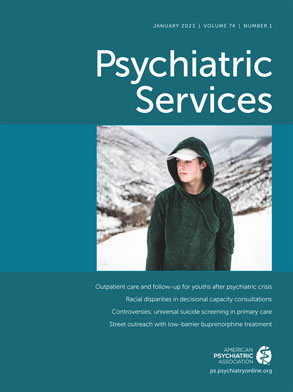Barriers to Client Engagement and Strategies to Improve Participation in Mental Health and Supported Employment Services
Abstract
Objective:
Methods:
Results:
Conclusions:
HIGHLIGHTS
Methods
SED
Clients
Analysis Plan
Results
Barriers to Accessing and Engaging in Services
| Theme | Definition |
|---|---|
| Complex behavioral health needs | Clients with complex or multiple psychiatric diagnoses, including high rates of unacknowledged co-occurring substance use disorders, posttraumatic stress disorder, or personality disorders |
| Complex medical needs | Clients with multiple medical diagnoses, including chronic pain, morbid obesity, or neurological and cardiovascular disorders, many of whom also did not have access to necessary primary or specialty medical care |
| Employment barriers | Clients who were unable or unwilling to work because of the severity of their illness, demands related to their health care needs, the need to care for family members, or not wanting to lose the opportunity for disability benefits |
| Unstable and traumatic relationships | Clients who did not follow treatment team recommendations because of mistrust, prominent emotional lability, or threatening and intimidating behavior directed toward staff |
| Significant social determinants of health | Clients with unstable housing or poverty or who lived in areas experiencing long-standing economic difficulties, including areas where few jobs of any type were available |
| Staff burnout, helplessness | Staff experiencing high levels of stress and burnout |
Complex behavioral health conditions and medical comorbid conditions.
Lack of motivation to work.
Difficult relationships.
Social determinants.
Staff burnout.
Strategies for Addressing Barriers
| Theme | Definition |
|---|---|
| Maintain persistent commitment | Maintain ongoing support and contacts and do not discharge clients who are not actively engaged in care |
| Consolidate and coordinate care | Decrease fragmentation of care by consolidating services among as few providers as possible and by ensuring ongoing care coordination |
| Use established practices to foster engagement | Reach out to and engage clients by using strengths-based, motivational-interviewing, trauma-informed, and harm-reduction approaches |
| Foster staff and team morale | Team leaders anticipate and actively manage staff stress reactions, such as anger, fear, resentment, and helplessness |
| Calibrate goals | Use a person-centered approach to identify client goals that are relevant and realistic |
| Clarify and address complex medical care needs | Provide information and educate team members regarding complex psychiatric and medical conditions and treatment needs |
| Advocate for client and combat stigma | Educate patients, family members, and team staff about the nature and impact of stigma associated with mental illness and mental health care |
Be persistent.
Coordinate services.
Provide trauma-informed care.
Calibrate goals.
Understand complex medical conditions.
Foster team morale.
Discussion
Conclusions
Acknowledgments
References
Information & Authors
Information
Published In
History
Keywords
Authors
Competing Interests
Funding Information
Metrics & Citations
Metrics
Citations
Export Citations
If you have the appropriate software installed, you can download article citation data to the citation manager of your choice. Simply select your manager software from the list below and click Download.
For more information or tips please see 'Downloading to a citation manager' in the Help menu.
View Options
View options
PDF/EPUB
View PDF/EPUBLogin options
Already a subscriber? Access your subscription through your login credentials or your institution for full access to this article.
Personal login Institutional Login Open Athens loginNot a subscriber?
PsychiatryOnline subscription options offer access to the DSM-5-TR® library, books, journals, CME, and patient resources. This all-in-one virtual library provides psychiatrists and mental health professionals with key resources for diagnosis, treatment, research, and professional development.
Need more help? PsychiatryOnline Customer Service may be reached by emailing PsychiatryOnline@psych.org or by calling 800-368-5777 (in the U.S.) or 703-907-7322 (outside the U.S.).

